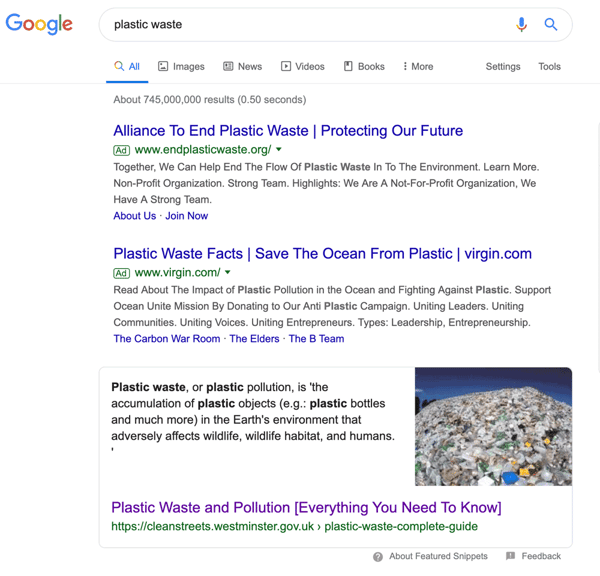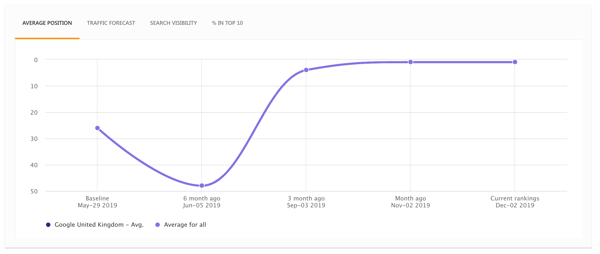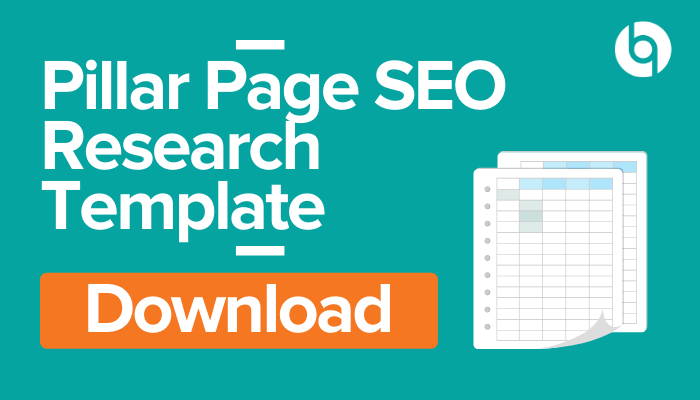It’s the dream of every inbound marketer and content specialist: how can we get to the top of page one? After all, high-ranking content indicates that you have the search engine’s trust, it evidences the calibre of your copy, and it brings increased traffic to your website, right?
80% of people trust Google’s results and recommendations.
But getting there is easier said than done. Somewhere between 6 and 10 million blog posts are published every day (!), meaning that competition for the top spots is hotter than ever.
This was the challenge Westminster City Council Commercial Waste Services (WCC) faced when it sought to create and optimise a plastic waste pillar page for its website. What tactics could the team use to take the top spot and the lion’s share of the clicks?
Read on to find out how WCC search-optimised its pillar page to rank fourth in Google for a competitive term and trigger a featured snippet in position zero — and how you can drive the success of your inbound marketing strategies by doing the same.
Optimising its pillar page was one part of WCC’s wider inbound strategy. Read the case study to discover how we helped it increase its online presence by 200%.
Starting with a solid foundation of keyword research
When it came to optimising WCC’s plastic waste pillar page for search, the first step was to identify a suitable keyword focus. The purpose of the page was to attract new visitors to the website, so it was important that it targeted a search term with sizeable volume.
Research is everything to a pillar page. Without it, you have no way of knowing the best keyword to target, the intent behind searches for that keyword, or what a page optimised for that keyword needs to include. In other words, you’re going in blind.
Researching the top five search results for ‘plastic waste’ provided WCC with direction on the optimal word count for the pillar page. Analysing the domain authority of each page revealed just how difficult it would be to rank for that particular keyword. Fortunately, WCC’s Cleanstreets website has a .gov domain, giving it high authority and a competitive chance.
Reviewing the performance of other high-ranking pages also highlighted the kind of copy they included, from which it was possible to work out what needed to be referenced in WCC’s pillar page and where the opportunities were to provide additional information.
If you’re looking to optimise a similar page and you’ve identified a primary or focus keyword (in this case, ‘plastic waste’), it’s important to also gather related or semantic keywords for reference throughout your copy.
Secondary keywords are important because they show Google you’re not only writing in-depth but at breadth. You’re covering lots of related information and giving Google plenty of clues as to what your page is about.
These could be related phrases and questions, or even variations of your primary keyword. As well as strengthening your on-page SEO, you can arrange them in a natural or logical flow and use them to better map out the content and structure of your pillar page.
Related read: 12 of the Quickest, Easiest SEO Tips and Tricks to Grow Your Organic Presence
Using searcher intent to inform your pillar page SEO
An effective webpage of any kind is one that provides value to the reader. In terms of pillar pages, this typically means creating an informative or educational page that answers your target buyer’s questions where possible, provides clear links to other more detailed articles, and includes prominent conversion points to your most helpful resources or other relevant downloads, providing the opportunity to exchange more valuable content in return for the reader’s email address.
To deliver on this aim effectively (and make keyword choices that are going to increase the page’s chances of ranking), it’s important that you understand the intent behind the keywords you’re considering.
Every keyword has intent, but that’s not always going to be a search for information. Many keywords can be thought of as commercial or branded. Put yourself in the target buyer’s shoes. What are they looking for — and what can you help them answer to start building trust?
When planning the keyword focus for its plastic waste pillar page, WCC came across a variety of informational search terms and questions it was capable of answering:
- What is plastic waste
- Which country produces most plastic waste
- Where plastic waste comes from
- Where does plastic waste go
- Why plastic waste is a problem
- Why reduce plastic waste
- How plastic waste can be better managed
- How much plastic waste is there in the world
To find what your audience is asking and deliver the content they’re looking for, AnswerThePublic is a helpful tool for uncovering long-tail search terms and informational phrases. Simply type in the root keyword (eg. ‘plastic waste’) and the site will generate a list of questions people are searching for in Google and Bing.
Aside from using AnswerThePublic, you can use Quora, Yahoo Answers or any other popular Q&A portal to find intent and the right keyword opportunity.
Creating a web of informative content for people and Google
Part of the process of optimising a pillar page for search is making sure it incorporates both external sources and your brand’s existing content, further improving the user experience.
Think of the pillar page as an informative hub (or ‘topic cluster’, in HubSpot terminology), linking out to everything your website has on the subject in question — from service pages, articles, and any downloadable guides to case studies and infographics. Linking to third-party content is also an effective way of educating and providing value to your readers, provided that third-party isn’t a competitor and the content you’re linking to can be trusted.
The use of internal and external links to create a web of helpful content doesn’t just benefit the human reader. When Google crawls the page, these links show the search engine that you’ve written authoritatively on the topic. It has a clearer idea of what your topic is, your expertise in this area, and when to show it to people searching for content like yours.
Along the same line of thought, Google can see that your visitors are spending time on the page. It recognises visitors are navigating via the links and engaging with the page by clicking on conversion points. All this helps it to reward your page as a higher search result.
When optimising their pillar page, WCC linked to a variety of pages across their own website, including the following:
- The relevant commercial waste management recycling services page on the website
- Their page on sustainability
- They linked to articles about ending plastic pollution and raising plastic waste awareness on the blog
- For the readers looking for more instructional, how-to content, WCC also incorporated its downloadable guides advising readers on how best to segregate waste, how to choose the right commercial waste supplier, and more broadly, how to reduce waste as a business
As for the credible external sources, links to domains with high authority such as Wikipedia’s plastic pollution page, National Geographic’s page on the plastic waste pollution crisis, and a BBC article on tips for reducing single-use plastic waste provided the extra informative hit.
Related read: How to Create Topic Clusters That Actually Boost Your Organic Ranking
Structuring your content for SERP success
Quality content is one of the biggest factors influencing a page’s ability to rank. In a nutshell, quality content that satisfies (if not exceeds) your readers’ expectations keeps them on the page and navigating around your site even as it answers their questions. For the same reason, it shows Google that your content is informative, valuable, and worthy of ranking high in the SERPs.
“Quality, high-ranking content starts with a plan”, explains Dr Thomas Brown, our Head of Content. “A pillar page is no different. Think back to your competitor research and the keywords you want to target. In what order should you answer these questions or explore these points to take the reader on a journey that leads them through the content?”
A ‘what is X’ question would make sense near the top of the page, introducing the reader broadly to the subject. You might follow that with ‘why is Y important’ and ‘what are the benefits of Z’, guiding the reader logically through the topic from top-level awareness to more commercial terms near the end.
Using its target keywords as a framework, WCC mapped out the page’s structure and the flow of the content to deliver as logical a pathway as possible. A contents section near the top of the page supports this, improving the page’s navigation by enabling the reader with a specific question to jump straight ahead to the relevant answer.
Jumping the search-engine queue by optimising for featured snippets
Did you know you don’t have to be the top-ranked listing to be selected for a featured snippet? In fact, you can get a featured snippet even if you’re in the 100th position. According to Getstat, 70% of snippets come from sites that aren’t top of the search engine results pages (SERPs). In this, WCC recognised an opportunity to jump ahead and give its pillar page the boost it needed to rank on page one and bring in the lion’s share of the clicks.
A featured snippet is a box at the top of your search results containing an instant answer to your question or search term. They’re also referred to as ranking in ‘Position 0’ because they’re actually located above the first organic search result. They often appear in the SERPs when a question-based query is being searched.
Featured snippets also come in three different types: paragraphs, lists and tables. As its name suggests, a featured snippet is short, often between 40-60 words or a short list of points providing a top-level answer with the option to click into the article and read more.
You already know the searcher intent, so you can use that to optimise your content for a featured snippet. Will a definition help the reader? Maybe a table with items and prices would be more appropriate or a list of steps?
With Westminster City Council’s plastic waste pillar page, we optimised the content to fit a paragraph snippet. When you’re targeting broader terms, like plastic waste, I’ve found that you’re more likely to trigger a featured snippet if you put a definition at the top of the page. Question-type headings can also help. Keywords starting with ‘what’, ‘why’ and ‘how’ have higher featured snippet rates and greater search volumes than regular keywords.
By combining these approaches, WCC was able to persuade Google to pull a definition from the page based on the answer to the first question, ‘What is plastic waste?’


Game your way to Google rankings with interactive elements
Have you ever clicked on an article and been hit with a wall of never-ending text? When you look at an article with dense blocks of words, it can be difficult to read. Breaking up the text with white space and adding visuals, videos, and other interactive elements are great ways to keep your readers engaged.
And as we’ve just discussed, the more engaged Google can see they are, the more likely it is to serve your content to others searching for your target keywords.
Drawing from its SERP and competitor research, WCC was able to review how visitors responded to the interactive elements on similarly themed pages. This analysis equipped the team with the insights it needed to incorporate the most effective interactive elements into its own pillar page, improving time on page and reducing bounce rates.
- In practice, this involved adding an interactive world map showing the countries producing the most plastic waste.
- The use of colourful images such as turtles and other animals swimming in a sea of plastic, and endless bags of plastic in landfills, provided visual clues to support the written content while breaking up the text and making the page more accessible.
- A further element was incorporated in the form of videos showing shocking facts about plastic and a BBC video on the future of the oceans.
We caught up with video software provider Vidyard’s CEO Michael Litt to explore how the smartest brands are using video for inbound marketing — read more.
Winning in the SERPs with SEO monitoring tools
Like much of inbound, search optimisation is something of a waiting game. But don’t confuse waiting with sitting back and expecting your page to rank. Getting your page to the top means optimising it over time to improve and retain its hard-won rankings. And that means keeping a close eye on how well the page is performing in the first place.
When the plastic pillar page initially launched in May 2019, it took just over a month to climb from position 48 to position 10. WCC’s ability to monitor and measure this jump was key to it being able to continue to optimise the page. The right SEO tools were instrumental to this.
It's more than just publishing it and letting it go. You have to keep monitoring it and look for the changes that you can make.
SEMrush has an on-page SEO checker that allows you to analyse the factors affecting your performance, provides actionable recommendations on how to improve your rank, and shows an in-depth comparison of Google’s top 10 performers using your focus keyword.
Using this optimisation tool, WCC was able to incorporate each SEMrush recommendation methodically. For instance, the tool revealed that WCC’s page featured the ‘plastic waste’ keyword 3% more in comparison to other pages on plastic waste. Based on this information, we were able to cut back on the usage of the keyword, build in more related and semantic terms, and see a boost in the Google ranking.


Other SEO tools you can use: Ubersuggest, LSIKeywords, Keywords Everywhere, Ahrefs
Staying on top of your search engine results rankings
After its initial launch at the end of May 2019, the page ranked 48th in the SERPs. By September, it had crept to the 4th position, and since 17th October it has been ranking as a featured snippet.
You should always be monitoring your pillar pages or articles making sure they are kept up-to-date. Does the content still match the searchers’ intent? Are you using enough relevant internal and external credible sources? Could you be using SEO tools to help boost your ranking if you fall? Are there enough interactive elements?
Creating a pillar page isn’t something you publish in a day and never look at again. It requires frequent monitoring, ensuring that the content is fully optimised to fit for featured snippets. As long as you follow the tips in this article, you’ll be well on your way to getting your own featured snippet.
Use our pillar page SEO spreadsheet template to guide you through all the research stages to win the SERPs and boost traffic for your chosen topic!
Heading
Separated they live in Bookmarksgrove right at the coast of the famous Semantics, large language ocean and many more stuff and more more more


Vaughn Armstrong is a Director at BabelQuest, an Elite-tier UK HubSpot Solutions Partner.




.png?width=50)

.png?width=50)
.png?width=50)



































